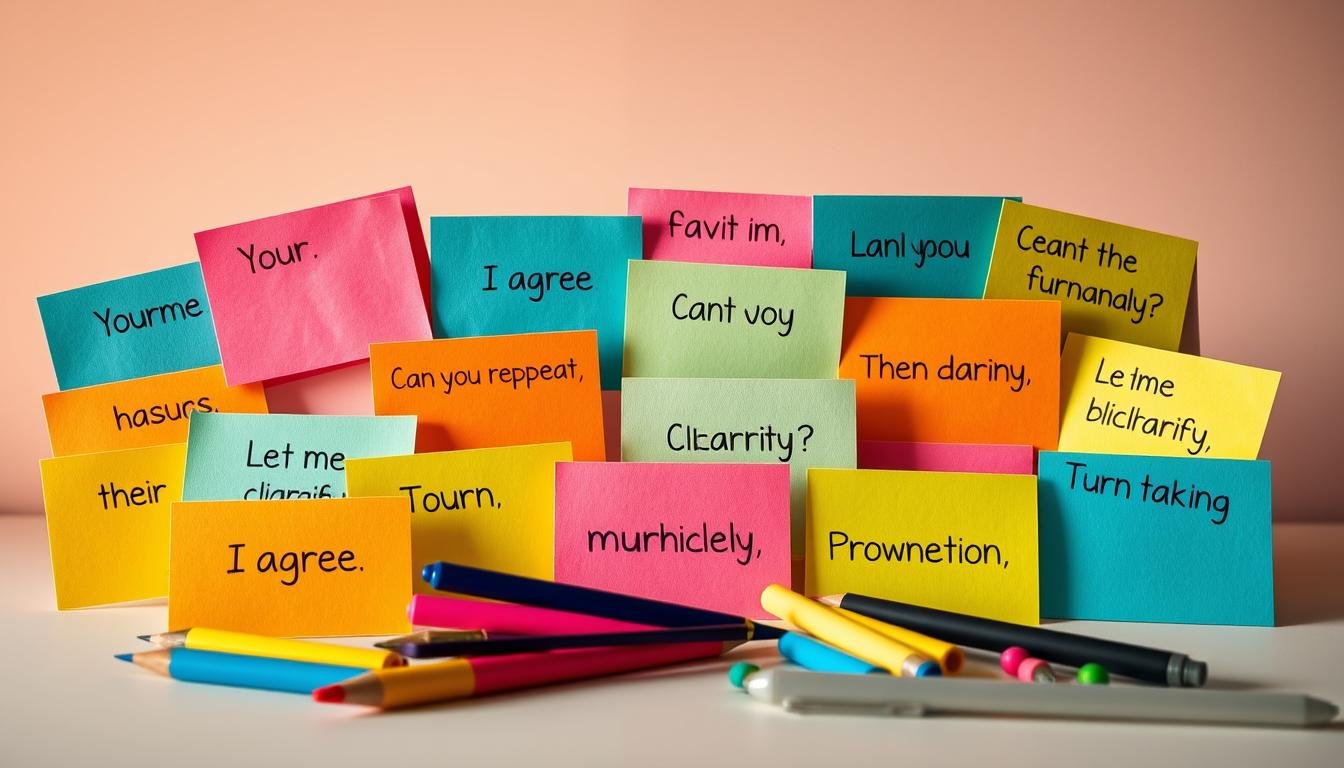Now Reading: Essential Vocabulary for Effortless Small Talk
-
01
Essential Vocabulary for Effortless Small Talk
Essential Vocabulary for Effortless Small Talk

Essential Vocabulary for Effortless Small Talk
Learning everyday chat vocabulary can really help you talk smoothly and enjoyably. Whether you’re talking to a clerk at a store or a cashier at a restaurant, the right words matter a lot.

Being good at starting and keeping a conversation going is a great skill. It can help you make new friends and find new chances. This article will show you the key vocabulary for small talk. It will help you feel more confident and clear in your daily chats.
Key Takeaways
- Learn basic vocabulary to start conversations
- Discover how to use conversation starters effectively
- Understand the importance of follow-up questions
- Explore advanced techniques for maintaining engaging conversations
- Develop the ability to adapt your vocabulary to different social situations
The Art and Importance of Small Talk
Small talk is like an art form, crucial for our social and work lives. It’s a key part of socializing vocabulary that helps us connect with others.
Small talk offers many benefits, both at work and in our personal lives. At work, it can open up new business chances, improve team bonds, and make the office a happier place.
Why Small Talk Matters in Professional Settings
In the office, small talk is a great way to bond with coworkers and clients. It helps start conversations, find common interests, and makes the atmosphere more friendly.
| Benefits | Description |
|---|---|
| Professional Networking | Small talk can lead to new business opportunities and strengthen professional relationships. |
| Social Bonding | Engaging in casual conversation can create a sense of camaraderie and shared experience. |
| Reduced Anxiety | Practicing small talk can help individuals become more comfortable when interacting with strangers. |
The Social Benefits of Casual Conversation
Using casual conversation words well can make talking more fun and strengthen social ties. It also helps us handle different social situations better.
Overcoming Anxiety About Talking to Strangers
Talking to strangers can make many nervous. But, by getting good at small talk and building a strong socializing vocabulary, we can feel more at ease when meeting new people.
Fundamental Vocabulary for Small Talk
To have easy small talk, knowing key words is key. This knowledge helps you feel confident in social situations.
Essential Nouns: Clerk, Cashier, and Other Occupations
Knowing job-related nouns is important for small talk. Terms like “clerk,” “cashier,” or “manager” help start work or daily life chats.
Here are examples: “The clerk at the info desk was super helpful,” or “My friend is a cashier at a local shop.”
Useful Adjectives: Appropriate, Interesting, Pleasant
Adjectives are key for describing people and experiences in small talk. Words like “appropriate,” “interesting,” and “pleasant” make talks better.
For example, “The movie was interesting,” or “The weather has been pleasant lately.”
Key Verbs: To Soak, To Engage, To Connect
Verbs are essential for showing actions and feelings in small talk. Verbs like “to soak,” “to engage,” and “to connect” are very useful.
For instance, “I love to soak up the vibe at outdoor events,” or “It’s easy to engage with folks at parties.”
Learning these basic words can really boost your small talk skills. It makes talking to others more fun and meaningful.
Effective Conversation Starters
Starting a conversation with strangers can be easy with the right starters. Good openers can spark interesting talks and help you connect with others.
Weather-Related Openers
Talking about the weather is a classic icebreaker. It’s a topic everyone can relate to. Simple comments like “Beautiful day today, isn’t it?” or “I’m glad the rain has stopped” can start a conversation.
Example phrases: “Lovely weather we’re having, isn’t it?” or “I love days like this.”
Location-Based Conversation Starters
Talking about where you are can also start a conversation. You can mention the venue, architecture, or local environment. For example, “This is my first time visiting this café. Have you been here before?” or “I love the view from here.”
Current Events as Icebreakers
Talking about current events can be a good way to start a conversation. But, it’s important to pick topics that won’t offend anyone.
How to Discuss Non-Controversial News
To talk about news without controversy, focus on positive or general interest stories. You can say, “Have you heard about the new exhibition in town?” or “I read an interesting article about [neutral topic] recently.”
Phrases for Sharing Opinions Respectfully
When sharing your opinion, be respectful. Use phrases like “In my opinion,” “I think that,” or “It seems to me that” to make your statements softer. This helps keep the conversation open and respectful.
By using these starters and being mindful of how to engage, you can become more comfortable and confident in starting and keeping conversations.
Mastering the Art of Follow-Up Questions
Follow-up questions are key to good small talk. They show you care and keep the chat going. Learning to ask them well can really help you connect with others.
Open-Ended vs. Closed Questions
It’s important to know the difference between open-ended and closed questions. Closed questions get a simple yes or no. Open-ended questions, on the other hand, lead to longer answers and deeper talks. For example, “Do you like your job?” is a closed question. But “What do you enjoy most about your job?” is open-ended.
Vocabulary for Showing Genuine Interest
Choosing the right words shows you’re really interested. Saying “That’s fascinating” or “Can you tell me more about that?” shows you value what they say. Using empathetic expressions like “I can understand why you’d feel that way” also strengthens the bond.
| Expression Type | Example Phrases | Purpose |
|---|---|---|
| Showing Interest | “That’s really interesting,” “Can you elaborate?” | Encourages the speaker to share more |
| Empathetic Responses | “I understand how you feel,” “That makes sense to me” | Creates a sense of mutual understanding |
| Transitioning Topics | “Speaking of [related topic],” “That reminds me of” | Smoothly moves the conversation to a new topic |
Transitioning Between Topics Smoothly
Getting good at switching topics takes practice. Phrases like “That reminds me of” or “Speaking of [related topic]” help. The goal is to link topics smoothly, keeping the conversation lively.
Vocabulary for Small Talk in Different Settings
Small talk varies by setting. It needs a specific approach for each place. This ensures you can chat easily in different situations.
Office and Workplace Terminology
In work settings, using terms specific to your field helps connect with others. Talking about current projects or workflow optimization works well. Saying “I’m excited for the deadline” or “The team is working hard” builds team spirit.
At work, you might chat about upcoming meetings or new projects. Knowing workplace jargon, like “synergy” or “disruptor,” makes talking easier.
Social Gathering Expressions
Social events are more relaxed and friendly. Commenting on the food or music is a good way to start a conversation. Saying “This venue is great” or “The vibe here is amazing” helps get things going.
Talking about shared interests or hobbies is also effective. Using words from popular culture or current events creates a common ground for talking.
Public Transportation and Waiting Area Conversations
In places like bus stations or waiting rooms, small talk often focuses on waiting or traveling. Mentioning the delay or crowd can start a conversation. Saying “It’s really busy today” or “I hope this train comes soon” is relatable.
Noticing the architecture or local scenery can also spark a conversation. Being friendly and approachable makes these chats enjoyable.
Cultural Considerations in American Small Talk
Cultural factors greatly influence how Americans chat casually. Knowing these subtleties can really help you get along better in social settings.

Appropriate Distance and Personal Space Vocabulary
In American culture, the right distance is key when talking. Being too close can be awkward, while being too far away might seem like you’re not interested. Using the right words about personal space can help you avoid these issues. Saying “Give me some space” or “I’m a bit uncomfortable with this proximity” can be helpful.
It’s also important to remember that personal space can differ from person to person and culture to culture. Paying attention to non-verbal signals and adjusting your distance can make interactions more comfortable.
Time-Related Expressions in American Culture
Time is a big deal in American small talk. People often talk about their schedules and plans. Saying “I’m running late,” “Let’s catch up soon,” or “That’s a great time slot” is common. Using these phrases can help you connect with others.
Being on time is highly valued in American culture. So, using phrases that show you respect time can be seen as polite.
Regional Differences in Conversational Styles
America is a mix of many cultures, and this affects how people talk. The speed of conversation can vary by region. Knowing these differences can help you adjust your way of talking to fit in better.
As Deborah Tannen, a famous linguist, noted, “Conversation is a ritual, and like any ritual, it’s governed by rules that are often unconscious.” Understanding these rules and being aware of regional differences can make your small talk more effective.
Topics to Embrace and Avoid
Mastering small talk in American culture means knowing what to talk about and what to skip. It’s all about understanding the situation and what others like to discuss.
Safe Topics for American Small Talk
Some subjects are always good for small talk in America. These include:
- Weekend plans or recent activities
- The weather or other light, relatable topics
- Hobbies or interests that can lead to engaging conversations
- Popular culture, such as movies, TV shows, or sports
Dale Carnegie said, “You can make more friends in two months by becoming interested in other people than you can in two years by trying to get other people interested in you.” Talking about safe topics helps build rapport and makes conversations more enjoyable.
Potentially Sensitive Subjects
While some topics are safe, others can be sensitive. It’s best to be careful with these:
- Politics or controversial social issues
- Personal finances or income
- Religion or deeply held beliefs
- Health issues or personal struggles
Knowing which topics to avoid can help you steer clear of awkward moments and keep conversations friendly.
Vocabulary for Gracefully Changing Topics
If a conversation starts to feel awkward, it’s good to know how to change the subject. Here are some helpful phrases:
- “That’s really interesting. By the way, have you…?”
- “Speaking of [related topic], I heard that…”
- “I’m curious about your thoughts on [new topic].”
Using these phrases can help you move to a more comfortable or interesting topic. This keeps the conversation fun and engaging.
Body Language and Verbal Cues
Small talk’s success depends on the balance between what’s said and how it’s received. It’s not just about the words, but also how you show yourself non-verbally.
Expressions for Active Listening
Active listening is key in small talk. It shows respect and interest in the other person. Here are some expressions to use:
- “That’s really interesting, can you tell me more?”
- “I’m sorry, could you elaborate on that?”
- “That’s a great point, I’d love to hear more about it.”
These phrases keep the conversation going and make the other person feel valued.
Phrases to Show Engagement
To show you’re engaged, use various verbal cues. For example:
- “I’m really enjoying our conversation.”
- “That’s so fascinating, I’ve never thought about it that way.”
- “I’m glad we had a chance to talk about this.”
These phrases help build rapport and make the interaction more fun.
Reading Conversational Signals
Understanding the other person’s signals is crucial. Pay attention to body language, tone, and conversation pace. For instance, leaning forward and eye contact show engagement. Avoiding eye contact or crossing arms might mean disinterest or discomfort.

Digital Small Talk: Vocabulary for Online Interactions
In today’s world, online chats are a big part of our lives. When we send emails or messages, we need to think about our words and tone.
Email and Messaging Greetings
A good greeting can make a conversation start off right. Email greetings should be short, clear, and fit the situation.
Video Call Conversation Starters
Good starters for video calls include asking how someone’s day is going. You can also talk about the latest news or share a personal story. Asking for advice or suggestions is another great way to begin.
Social Media Engagement Phrases
Being real and friendly is key on social media. Use a tone that feels like talking to a friend. Ask questions, share your own stories, and respect others’ views.
Practice Exercises for Small Talk Mastery
This section will help you improve your small talk skills. We’ll cover role-playing, building your vocabulary, and practicing in real-life situations.
Role-Playing Scenarios with Sample Dialogues
Role-playing is a great way to get better at small talk. It helps you feel more at ease and confident in conversations. Here are some dialogues to start with:
- Ordering food at a restaurant: Practice ordering and answering the server’s questions.
- Discussing the weather: Talk about the weather, saying things like “It’s a beautiful day, isn’t it?” or “I’m glad it’s cooling down.”
- Talking about hobbies: Share your hobbies with others, saying “I’m really into ” or “I’ve been playing for years.”
Vocabulary Building Activities
To grow your vocabulary, try these activities:
- Read different texts, like news, blogs, or books.
- Keep a notebook for new words and phrases.
- Play word games like Scrabble or Boggle for fun.
Real-World Practice Opportunities
Here are ways to practice your skills:
- Talk to strangers, like on public transport or in line.
- Chat with coworkers or friends at work or parties.
- Join online forums or groups, saying “I’d love to hear your thoughts” or “What do you think about ?”
By practicing in different places, you’ll get better at small talk. Be yourself, listen well, and show you care about others.
Conclusion: Building Confidence in Everyday Conversations
Mastering small talk is a valuable skill that boosts your interactions with others. By learning everyday chat vocabulary and phrases, you’ll feel more confident in conversations. This makes talking to people more enjoyable and effortless.
Building confidence in conversations comes from practice and facing different social situations. As you use the vocabulary and phrases we’ve discussed, you’ll get better at talking smoothly. Your conversations will become more natural and enjoyable.
Small talk isn’t about memorizing lines for every conversation. It’s about feeling comfortable using everyday words in different situations. This way, you can handle various social settings with ease, making your interactions more fun and effective.
With regular practice and a desire to learn, you’ll grow more confident in everyday talks. This will make you a better and more engaging person in both your personal and professional life.
Small talk is a skill that grows with time, effort, and patience. Keep working on your skills and confidence. You’ll become a more skilled and engaging conversationalist.
## FAQ
### Q: What are some common conversation starters for small talk?
### A: You can start by talking about the weather or asking about someone’s weekend. You can also comment on current events.
### Q: How can I make my small talk more engaging?
### A: To engage more, use open-ended questions and show real interest in others. Also, smoothly move between different topics.
### Q: What are some tips for overcoming anxiety about talking to strangers?
### A: To feel less anxious, listen actively and use positive body language. Focus on the other person.
### Q: How can I change the subject if a conversation becomes uncomfortable?
### A: Use phrases like “Speaking of which” or “That reminds me” to move to a new topic.
### Q: What are some safe topics to discuss in American culture?
### A: Safe topics include hobbies, travel, food, and common interests. Also, share lighthearted stories or anecdotes.
### Q: How can I show genuine interest in others during a conversation?
### A: Show interest by asking follow-up questions and using phrases like “That’s interesting.” Say “Tell me more about that.”
### Q: What are some examples of follow-up questions?
### A: Good follow-up questions ask for more information or clarify a point. You can also seek additional details.
### Q: How can I practice my small talk skills?
### A: Practice by role-playing, joining group discussions, or observing and imitating others.
### Q: What is the importance of non-verbal cues in small talk?
### A: Non-verbal cues like body language and tone of voice show interest and engagement.
### Q: How can I effectively use digital communication for small talk?
### A: For digital small talk, use greetings and conversation starters. Choose phrases that fit the platform, like emails or social media.






























